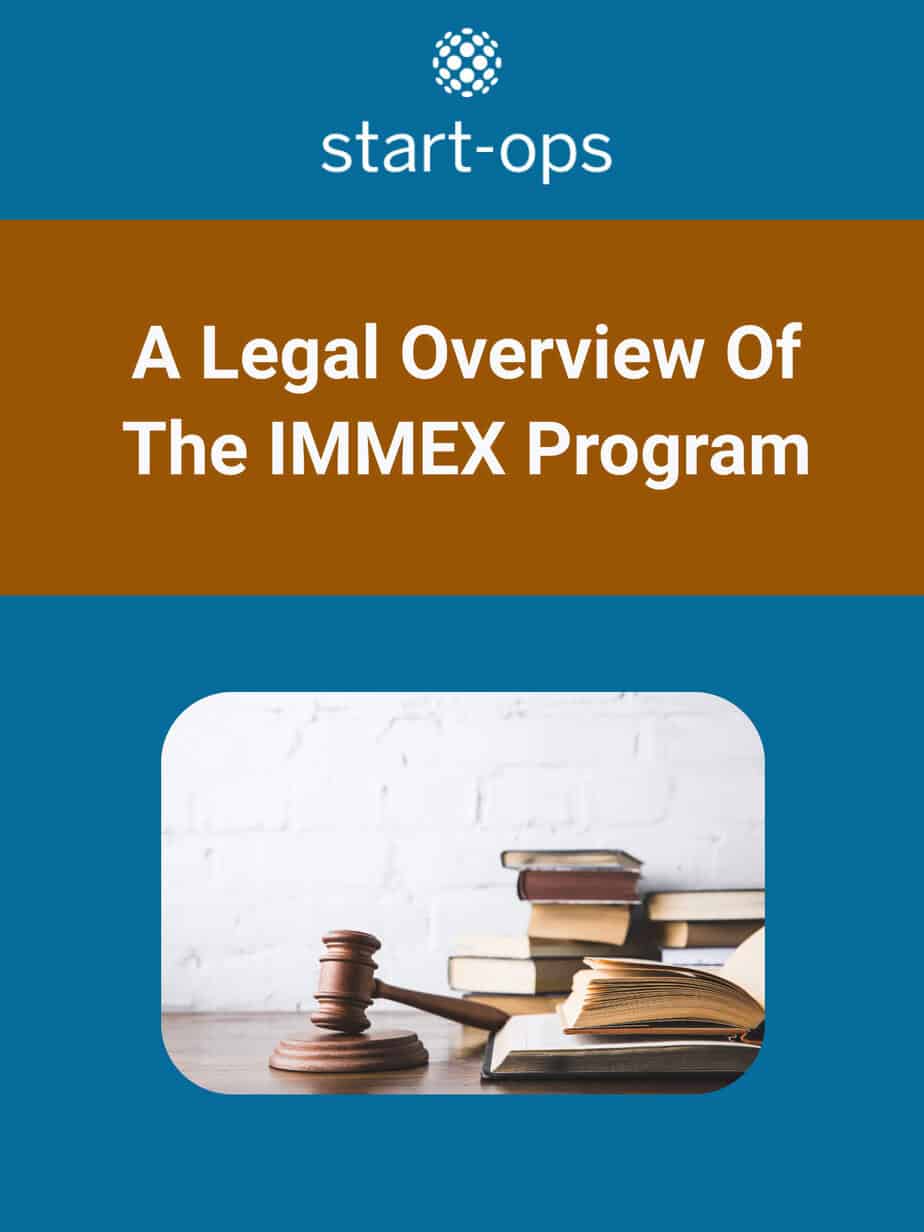Last updated on June 12th, 2025 at 08:00 pm
For foreign enterprises planning to establish manufacturing operations in Mexico, the choice of market entry strategy is a critical decision with long-term financial and operational implications. The landscape of available options is complex, but among them, the IMMEX Shelter Program stands out as a uniquely powerful framework. It is expertly designed to accelerate startup times, provide cost predictability, and, most importantly, mitigate the significant risks associated with navigating a new regulatory environment.
While often perceived as a temporary or introductory option, a deeper analysis reveals the Shelter Program to be a sophisticated strategic tool that offers unparalleled protection and efficiency. Understanding its legal architecture, the clear division of responsibilities it creates, and its profound operational advantages is essential for any company seeking a competitive and secure foothold in Mexico.
This guide provides a definitive analysis of the IMMEX Shelter Program, moving beyond surface-level definitions to explore its core mechanics, strategic benefits, and ideal applications for today’s global manufacturer.
Deconstructing the Shelter: The Legal and Operational Architecture
The IMMEX Shelter Program is a specific modality of the IMMEX program, fully sanctioned under Article 1, section III of the IMMEX Decree, which permits a foreign company to conduct manufacturing activities in Mexico under the legal umbrella of a licensed Mexican entity. This structure establishes a contractual relationship that allows the foreign company to operate in Mexico without establishing a direct legal presence.
The core concept is a clean separation of functions. The foreign company, or “client,” provides the proprietary elements of the business: its production processes, specialized machinery, raw materials, and key technical personnel. The Mexican shelter company provides the entire local legal and administrative infrastructure.
This arrangement means the foreign company has no Mexican corporation, no Mexican tax ID, and no direct employees on a Mexican payroll. The shelter company serves as the legal face of the operation before all Mexican governmental bodies, including the Tax Administration Service (SAT), the Secretariat of Economy, the Ministry of Labor, and the Mexican Social Security Institute (IMSS). The client’s entire operation functions as a distinct project or cost center within the shelter’s established, compliant corporate structure, effectively insulating the foreign enterprise from direct legal and fiscal liability.
The Division of Responsibilities: A Framework for Focus
The strategic genius of the shelter model lies in its clear and contractually defined division of labor. This separation allows each party to concentrate on its fundamental competencies.
The Shelter Provider’s Domain: The Administrative Infrastructure
A professional shelter provider assumes the full spectrum of local operational and administrative responsibilities. This comprehensive service portfolio includes:
- Corporate and Legal: The shelter provides the established Mexican corporation and is the holder of the IMMEX registration, the crucial VAT & IEPS Certification (A, AA, or AAA), and all other federal, state, and municipal permits required to operate legally.
- Human Resources and Payroll: The shelter acts as the legal employer of record for all personnel, from line operators to management. This encompasses the entire HR lifecycle: recruitment, hiring according to Mexican labor law, payroll administration, social security (IMSS) contributions, profit-sharing (PTU) calculations, benefits management, and legal terminations, including the calculation and payment of severance (finiquito). Any labor disputes or litigation are the direct responsibility of the shelter provider.
- Accounting and Tax Compliance: The shelter’s team of accountants manages all local bookkeeping, prepares financial reports, and ensures the timely and accurate filing of all federal and state tax declarations (VAT, income tax, payroll taxes). Maintaining a positive “Opinion of Compliance” from the SAT is a core function of the shelter.
- Customs and Trade Compliance: This is a critical function central to the IMMEX program. The shelter manages all import and export operations, including the relationship with Mexican customs brokers. Its team is legally responsible for the administration of the Annex 24 inventory control system and the Annex 31 tax credit system. All customs declarations (pedimentos) are processed under the shelter’s name and registration, and the shelter is the entity that faces any potential customs audits.
- Facilities and General Administration: The shelter typically manages the industrial real estate lease, facility maintenance, utilities, security, and other general administrative services needed for the day-to-day operation of the plant.
The Foreign Company’s Domain: The Core Production Mission
With the shelter managing the comprehensive administrative infrastructure, the foreign company is liberated to focus exclusively on its primary mission: manufacturing its product to the highest standards. The client’s responsibilities include:
- Production Control: Directing the day-to-day manufacturing schedule, implementing quality control protocols, and managing all aspects of the production process itself.
- Machinery and Equipment: Supplying all necessary production machinery and equipment. These assets, while housed in the shelter’s facility, remain the property of the foreign company and are temporarily imported under the shelter’s IMMEX program.
- Inventory Management: Sourcing, procuring, and financing the raw materials and components required for production. The client retains ownership of the inventory throughout the manufacturing cycle.
- Technical Oversight: Providing the key technical experts—such as engineers, quality assurance managers, and production specialists—to train the local workforce and ensure the correct implementation of proprietary processes.
- Commercial Strategy: Managing all customer relationships, sales contracts, marketing, and distribution of the final product.
Strategic Advantages of the Shelter Model
This clear division of labor creates powerful, tangible advantages, primarily centered on accelerating market entry and mitigating operational risks.
1. Unparalleled Speed to Market: The process of establishing a new legal entity in Mexico is lengthy and complex, often taking 6 to 12 months to complete all necessary registrations and permit applications. In contrast, operating through an existing shelter allows a company to bypass this entire process. With the legal and administrative framework already in place, a manufacturing operation can often become fully functional within 6 to 8 weeks. This radical compression of the startup timeline provides a significant first-mover advantage.
2. Comprehensive Risk Mitigation: This is the most compelling benefit of the shelter model. It contractually transfers the burden of navigating Mexico’s complex regulatory environment to a local expert.
- Labor Liability: Mexico’s Federal Labor Law is intricate and strongly protective of employees. The shelter, as the legal employer, assumes all liabilities related to hiring, firing, severance pay, and potential labor disputes, protecting the foreign company from direct exposure.
- Fiscal and Tax Liability: The consequences of errors in Mexican tax declarations can be severe. The shelter’s accounting team is responsible for accurate compliance, insulating the client from penalties associated with potential miscalculations or changes in fiscal law.
- Customs and Regulatory Liability: The IMMEX program’s compliance demands are stringent. An error in customs declarations or inventory control can jeopardize the entire operation. The shelter assumes this responsibility, as its own IMMEX registration is at stake.
3. Cost Predictability and Reduced Overhead: The shelter model provides significant financial clarity. Instead of building and funding a full administrative department—including accountants, HR managers, and trade compliance specialists—the foreign company pays a predictable management fee. This fee, often structured per employee or per production hour, converts numerous variable overhead costs into a stable, forecastable operating expense.
4. Concentration on Core Competencies: The shelter framework enables the foreign company to dedicate its capital and human resources to its areas of expertise: product innovation, manufacturing efficiency, and quality control. It avoids the costly and distracting learning curve associated with mastering foreign administrative, legal, and fiscal systems.
The Shelter Lifecycle: Financials and Strategic Graduation
The financial relationship is straightforward: the foreign client pays the shelter a service fee, and the shelter pays all local operating costs from those funds. While a company can operate under a shelter for an extended period, the model is often leveraged as a strategic incubator, particularly due to Mexican tax law.
Current tax provisions grant a “safe harbor,” allowing a foreign company to operate via a shelter for up to four years without creating a “permanent establishment” for income tax purposes in Mexico. This provides a four-year window of income tax exemption for the foreign entity. This timeline creates a natural lifecycle for the shelter relationship, culminating in a “graduation.”
After establishing a stable and successful operation over 3-4 years, the company can seamlessly transition to its own independent entity.
This process involves:
- Incorporation: The foreign parent company establishes its own Mexican subsidiary.
- Permit Application: The new subsidiary applies for its own IMMEX program and VAT & IEPS Certification.
- Asset Transfer: The machinery and equipment are legally transferred from the shelter’s IMMEX program to the new entity’s program through established customs procedures.
- Employee Transfer: The entire workforce is moved from the shelter to the new subsidiary via a legal “employer substitution” (sustitución patronal), which protects employee seniority and rights.
Ideal Candidate Profile for a Shelter Program
The shelter model, while broadly beneficial, provides maximum value to companies with specific profiles.
A shelter is an optimal solution for:
- New Entrants to the Mexican Market: It is the definitive de-risked entry strategy for companies with no prior operational experience in Mexico.
- Medium-Large Enterprises (SMEs): Companies ready to pay a premium for starting operations fast.
- Project-Based or Time-Sensitive Operations: Manufacturers working on specific contracts with defined timelines can leverage the shelter’s rapid setup and simplified exit strategy.
- Risk-Averse Corporations: Organizations that place a high premium on mitigating legal, fiscal, and labor liabilities will find the shelter’s protective framework invaluable.
A shelter may be less suitable for:
- Very Large-Scale Operations: At a massive scale (e.g., thousands of employees), the economics may favor establishing a dedicated internal administrative division.
- Companies with Highly Specialized Needs: Operations requiring unique permits or handling materials not typically managed by shelters might require a more direct approach.
Conclusion
The IMMEX Shelter Program is a sophisticated and highly effective strategic instrument for manufacturing in Mexico. It offers a clear path to minimizing risk, accelerating market entry, and achieving cost predictability. Outsourcing the entirety of the complex local administrative burden allows foreign manufacturers to focus their resources on production excellence and business growth.
Please leave your comments if you have any, and don’t hesitate to get in touch with us if needed.



Add your first comment to this post